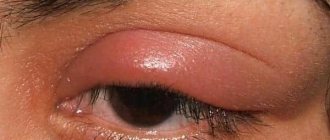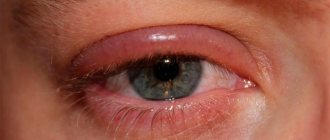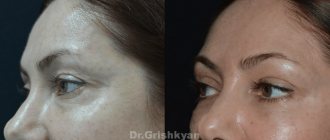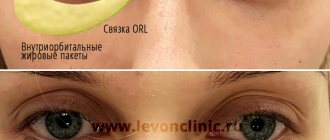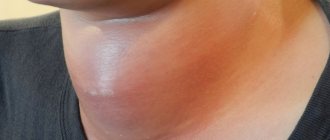Quincke's edema in children
- Symptoms of the disease
- How does Quincke's edema begin in a child?
- Causes
- First aid
- Treatment of Quincke's edema in children
Attacks most often occur in children with urticaria. Pediatricians associate swelling with hay fever, bronchial asthma, and atopic dermatitis.
Important! This is a dangerous condition, which in a quarter of cases provokes swelling of the larynx.
Quincke's edema occurs in newborns and older children. Its nature is most often allergic, but this phenomenon can be hereditary and also have no clear origin. Source: I.I. Balabolkin. Urticaria and angioedema in children // Pediatrics, 2009, v. 87, no. 2
The prognosis is usually favorable; it becomes poor with frequent relapses and associated swelling of the internal organs and larynx. The consequences may be anaphylactic shock, bronchospasm.
For prevention, in some cases vaccination is carried out. Its necessity is determined individually. Clinical recommendations for parents: provide the child with a low-allergen diet, take antihistamines at intervals recommended by the doctor, minimal or no contact with the allergen.
Complications
If measures are not taken in time, the consequences of Quincke's edema can become life-threatening. This applies, first of all, to damage that affects the mucous membrane of the larynx, as well as the meninges with symptoms of meningitis. These complications in most cases lead to the death of the patient.
With angioedema, anaphylactic shock often develops. This reaction is extremely life-threatening and affects the functioning of the entire body. Its main symptoms:
- swelling of the oropharynx, larynx and tongue;
- generalized itching;
- hives;
- bronchospasm, lacrimation;
- nausea, vomiting, diarrhea;
- tachycardia, hypotension, arrhythmia, acute heart failure;
- convulsions, suffocation, coma.
Symptoms of the disease
The reaction develops rapidly; signs of angioedema in children are swollen lips, neck, and face. The upper torso, hands, feet, and genital area are often affected. Quincke's edema is visible in the eyes of a child - the eyelids swell on one or both sides.
- When the tonsils are affected, the picture is similar to a sore throat.
- Edema of the larynx is indicated by a hoarse voice, difficulty breathing, a gusty cough, blue discoloration and then gradual paleness of the skin.
- Swelling that appears in one area may occur in another. This mainly applies to large-scale swelling.
- When the mouth and tongue swell, speech becomes difficult.
- If the process is localized in the gastrointestinal tract, the child may complain of tingling of the tongue, followed by diarrhea and vomiting, and sharp pain in the intestinal area.
- Rarely, swelling of the meninges occurs. With it, the child cannot fully tilt his head forward, complains of a headache, and behaves inhibited. Convulsions and vomiting may occur.
- If only the skin is affected, joint pain, fever may appear, and the child may lose consciousness.
The pathological condition can last from an hour to several days.
How does angioedema begin in a child?
Immediately after contact with the allergen, the listed symptoms increase sharply. This happens in a matter of minutes. Source: G. I. Smirnova. Urticaria and Quincke's edema // Allergic diseases in children. Ed. M.Ya. Studenikina, I.I. Balabolkina. M.: Medicine, 1998: 279-287 If you press on the swollen area, the child will not experience pain, but you will feel a dense swelling, on which, after pressing, there will be no characteristic depression.
Let's look deeper...
Why does swelling occur?
The human body contains a special substance - histamine. Normally, it is found in cells called mast cells. They are found in connective tissue, lymph nodes, spleen and bone marrow and do not show themselves for the time being. As soon as a focus of inflammation occurs in the body, mast cells receive a signal from other cells, become activated and release “charges” of histamine and other substances into the blood. Histamine causes expansion of capillaries and increases the permeability of their walls. This leads to swelling in the lesion, blood flow increases and slows down, which means more and more protective cells (neutrophils and lymphocytes) are concentrated. They will help the body cope with inflammation.
The same thing happens with Quincke's edema (only there is no focus of inflammation itself, and completely other factors, sometimes quite harmless, provoke the release of histamine). And here mast cells release histamine, which causes expansion of the capillaries, increases the permeability of their walls, which leads to tissue swelling. With Quincke's edema, the process involves the deep layers of the skin and subcutaneous tissue. Urticaria is the same as Quincke's edema according to the mechanism of development, only the upper layers of the skin are involved in the process. At the same time, at the site of histamine action, blood vessels dilate, connective fibers swell and small accumulations of inflammatory cells (mainly neutrophils and lymphocytes) appear.
Quincke's edema can occur as a result of three mechanisms: allergic, non-allergic and mixed.
- With an allergic mechanism (which is extremely rare for children under 3 years of age), the child first enters the allergen for the first time (in the form of a drug, food product, pollen or insect venom). The body takes it for an enemy agent (antigen) and produces an entire army of immunoglobulins (IgE antibodies) against it. Those, like guards, are attached to the membrane (shell) of mast cells like a palisade. These antibodies have a good and, most importantly, specific memory: they clearly remember what their antigen looks like. If the allergen arrives a second time, it binds to the IgE antibody on the surface of the mast cell, which leads to its destruction with the release of histamine. That is, Quincke's edema (like any other allergic reaction) develops when the antigen is repeatedly exposed.
- In a non-allergic reaction (which occurs much more often in children), histamine is released when some factor (insect venom, medicine, food coloring, etc.) directly affects the mast cell wall.
- Hereditary angioedema (Quincke's disease) is classified as mixed forms. There are invisible soldiers in the blood (complement system from the Latin complementum - addition), of which there are about 20 (01, 02, etc.). If a foreign agent enters the blood, they begin to actively influence each other. To make it easy to imagine: when meeting with a “stranger,” the first 01 wakes up and pushes the second 02; he bothers the third 03 (the third is sometimes activated without the first two); the third - the fourth, and so on - until a “heap of small things” is formed, which with its power breaks through the cell wall. In fact, these are, of course, not soldiers, but proteins that are in an inactive state. They would be happy to constantly activate and destroy cells (not only foreign ones, but also their own), but they are hampered by their bosses (inhibitor proteins), who constantly suppress their activity.
Problems with a genetic breakdown arise when there is little (from 5 to 30% of the norm) in the blood of those most formidable bosses - protein 01 or 03 inhibitor. Protein 01 in this case is happy to try: it “blows the whistle” for any unnecessary reason. A child cuts himself, gets nervous, becomes hypothermic, undergoes surgery - complement is activated and Quincke's edema occurs, and often the most unfavorable option is with swelling of the larynx, less often - of the gastrointestinal tract or meninges. When interviewed, it turns out that in the family from generation to generation there have been cases of laryngeal edema in relatives. This allows us to suspect the hereditary nature of the edema. Fortunately, such cases of the disease are very rare.
Causes
A complex of immunological reactions is most often caused by:
- Food;
- medicines;
- volatile allergens (pollen, chemicals, etc.);
- insect bites.
The disease may be non-allergic in nature. In this case, in addition to allergens, it is caused by: stress, infectious diseases, external factors (for example, hypothermia), intoxication of the body. Source: A. V. Lyapunov. Urticaria and Quincke's edema in children // Children's allergology. Ed. A.A. Baranova, I.I. Balabolkina. M.: GeotarMedia, 2006; 486-497.
Medicine also knows quite a lot of cases where the reason for such a reaction of the body has not been established.
Diagnostics
Before starting treatment, it is important to correctly determine the cause of the disease and find out what caused Quincke's edema.
First of all, the specialist studies the medical history and also asks the patient about the possible connection of this condition with the use of certain foods, medications, etc. This can be confirmed by taking appropriate allergy tests or by identifying a specific type of immunoglobulin in the blood. In parallel with allergy tests, a general analysis of urine, blood, and biochemical components of plasma is assessed. Additionally, the doctor takes a sample to analyze various elements in the complement system, feces for helminths and protozoa. When diagnosing, it is important to exclude autoimmune diseases, as well as blood and intestinal pathologies.
First aid
call an ambulance immediately . Doctors may decide on emergency hospitalization if the patient has difficulty breathing, a swollen tongue, or symptoms indicating intestinal damage.
What to do before the doctors arrive?
First aid, which should be provided at the first symptoms of angioedema in children, involves clearing the airways, checking breathing intensity, heart rate, and blood pressure. Sometimes it is necessary to perform cardiopulmonary resuscitation, so after the first case, parents are recommended to take first aid courses. At the final stage, medications should be administered to the child.
First aid equipment includes:
- glucocorticosteroids (“Prednisolone”, “Dexamethasone”);
- antihistamines;
- adrenalin.
Sequence of administration: adrenaline, then glucocorticosteroid, then antihistamine. If the reaction is moderate, then adrenaline is excluded.
| Adrenalin | It is injected intramuscularly into the thigh (middle third outside) at the rate of 0.01 mg for each kg of the child’s weight. If there is no effect, then the injections are repeated every 15 minutes. |
| Glucocorticosteroids | Injected intramuscularly into the buttock or intravenously. You can pour the medicine from the ampoule under the tongue - this way the effect will come faster. The dosage of Prednisolone is from 60 to 150 mg, Dexamethasone is from 8 to 32 mg. |
| Antihistamine | Intramuscular injection is preferable. It is possible to take a pill, but the effect will come later. The dosage depends on the medicine. For example, “Loratadine” – 10 mg, “Cetrizine” – 20 mg. |
Important! In case of swelling of the larynx, a tracheostomy is performed urgently.
Prognosis and prevention
To prevent the development of soft tissue swelling, it is important to follow certain rules:
- avoid contact with products and drugs that cause allergies;
- If you have such reactions to certain types of medications, be sure to inform your doctor;
- When taking a new type of antibacterial drug, keep antihistamines on hand;
- eat right;
- follow a gentle diet;
- take vitamin complexes to strengthen the human immune system.
If the cause of swelling is a food allergy, then the diet should be adjusted and selected very carefully. There are a number of foods that are more likely to cause illness:
- strawberries;
- fish;
- eggs;
- seafood;
- citrus;
- strawberry;
- nuts.
If food has become the cause of the pathology, then doctors sharply limit the diet, but such a diet cannot be maintained for a long time. The body must receive the full range of necessary components, so fasting cannot be prolonged.
Treatment of angioedema in children
- stopping contact with the allergen;
- removal of the allergen from the body (sorbents, drinking plenty of fluids);
- the use of antihistamines, glucocorticosteroids, diuretics and other drugs, depending on individual indications.
The treatment plan may vary and include other interventions and complex drug therapy. It depends on the type of disease, the number of relapses and other factors. It is necessary to obtain specialist advice.
Sources:
- I.I. Balabolkin. Urticaria and angioedema in children // Pediatrics, 2009, v. 87, no. 2.
- G. I. Smirnova. Urticaria and Quincke's edema // Allergic diseases in children. Ed. M.Ya. Studenikina, I.I. Balabolkina. M.: Medicine, 1998: 279-287.
- A. V. Lyapunov. Urticaria and Quincke's edema in children // Children's allergology. Ed. A.A. Baranova, I.I. Balabolkina. M.: GeotarMedia, 2006; 486-497.
Grek Elena Anatolyevna Clinic
Author of the article
Grek Elena Anatolyevna
Doctor of the highest qualification category
Specialty: allergist
Experience: 24 years
The information in this article is provided for reference purposes and does not replace advice from a qualified professional. Don't self-medicate! At the first signs of illness, you should consult a doctor.
Treatment
What measures need to be taken outside the acute phase of the disease?
First of all, it is necessary to completely eliminate the patient’s contact with the identified allergen.
Therapeutic measures are carried out in two stages: stopping the acute process, eliminating the causes of the disease.
- Short courses of hormones that temporarily “block” the immune system’s reactions.
- Drugs to strengthen the central nervous system (calcium, ascorbic acid).
- Vitamin complexes, Ascorutin to reduce vascular permeability, gammaglobulins.
- The use of histamine H1 receptor blockers (anti-allergic) to reduce sensitivity to the allergen and prevent subsequent histamine production.
Treatment of hereditary angioedema has a number of distinctive features. Incorrect diagnosis can cause death.
Prices
| Name of service (price list incomplete) | Price |
| Appointment (examination, consultation) with an allergist-immunologist, primary, therapeutic and diagnostic, outpatient | 1950 rub. |
| Prescription of treatment regimen (for up to 1 month) | 1800 rub. |
| Consultation (interpretation) with analyzes from third parties | 2250 rub. |
| Consultation with a candidate of medical sciences | 2500 rub. |
| Allergen-specific immunotherapy (ASIT) - maintenance course (excluding the cost of the drug) | 8100 rub. |

